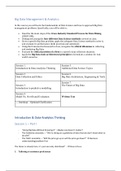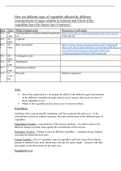Samenvatting
Complete Summary of all BDMA Lectures, Notes and a Practice Exam
- Instelling
- Erasmus Universiteit Rotterdam (EUR)
A comprehensive summary of the lectures that were based on the book ‘Data Science for Business; What You Need To Know About Data Mining and Data-Analytic Thinking’ written by Foster Provost & Tom Fawcett. The summary includes screenshots of all key concepts (i.e. learning objectives) of the co...
[Meer zien]






